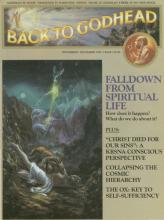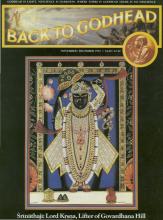
Richard L. Thompson (Sadaputa dasa), contributed over three dozen essays to Back to Godhead, "The Magazine of the Hare Krishna Movment," on the relationship between religion and science from a Vaishnava perspective. These peer reviewed essays by the magazine's editorial board featured Thompson's mature appreciation of professional scientific methodology, brought to bear with his seasoned experience as a Krishna devotee and formally initiated disciple of A.C. Bhaktivedanta Swami Prabhupada.
About Back to Godhead (BTG) Magazine
Back to Godhead magazine covers all aspects of the philosophy and practice of Krishna consciousness as taught by Bhaktivedanta Swami Prabhupada. Some recurring features in the magazine include lectures by Prabhupada, tours of Indian holy places, interviews with Hare Krishna devotees, Krishna conscious perspectives on issues of the day, excerpts from Vedic scriptures, and tips on practicing spiritual life in the modern age.
For an in-depth overview, please see: "The History of Back to Godhead Magazine" by Steven J. Rosen (Satyaraja Dasa). For a short biographical essay of Bhaktivedanta Swami Prabhupada, please see the iskcon.org article: "Founder-Acarya"
____________________________________________________________
List of BTG essays by Richard L. Thompson (Sadaputa Dasa)
Please click the "Article Title" to view. Click on images throughout this section to expand.
| Article Title | BTG Issue | Tagline | |
|---|---|---|---|
 |
"Can Creation Come From Chaos?" | June 1976 | Vol. 11 No. 6 | "A challenge to the prevailing scientific view that life comes from a chance combination of material elements." |
 |
"Two Ph.D.'s for Krsna" | June 1976 | Vol. 11 No. 6 | June 1976 interview with two of the Bhaktivedanta Institute's founding members, Sadaputa dasa and Madhava dasa, who describe how they came "to accept the philosophy of Krishna consciousness as scientifically sound." |
 |
"Chemistry and Consciousness" | September 1978 | Vol. 13 No. 9 | Scientific Views / The Bhaktivedanta Institute |
 |
"The Machinery of Evolution: Out of Gear?" | January 1979 | Vol. 14 No. 1 | "A mathematician finds flaws in one of Darwin's basic assumptions." |
 |
"Reality, Life, and Quantum Mechanics" | May 1979 | Vol. 14 No. 5 | "A mathematician points out that if we view the universe as a machine, the more we explain it the less we understand." |
 |
"On Inspiration" | December 1979 | Vol. 14 No. 12 | "The search for the source of inspiration in science, mathematics, and art leads beyond the mechanistic framework of present-day biological theory." |
 |
"Searching Past the Mechanics of Perception" | September 1980 | Vol. 15 No. 9 | "The deeper scientists probe into the nature of perception, the farther away their subject recedes." |
 |
"The Computerized Mr. Jones" | October 1980 | Vol. 15 No. 10 | "Can a machine be conscious? A mathematician analyzes what is meant by 'artificial intelligence.'" |
 |
"Chance and the Unity of Nature" | January/February 1981 | Vol. 16 No. 1-2 | "A mathematician challenges some basic premises of modern science." |
 |
"Evolution: A Doctrine in Search of a Theory" | May 1981 | Vol. 16 No. 5 | "Problem: If the standard evolutionary mechanism is inadequate, how can the origin of species be explained?" |
 |
"A Dialogue on 'The Ghost in the Machine'" | September 1981 | Vol. 16 No. 9 | "Is the existence of the soul merely a myth propagated by fuzzy-minded fanatics—or a fact verifiable by a non mechanistic science?" |
 |
"Bhakti-yoga: A Method of Nonmechanistic Science" | October 1981 | Vol. 16 No. 10 | "How can we study nonmaterial aspects of reality when we're living in a world of matter?" |
 |
"Bhakti-yoga: A Method of Nonmechanistic Science (Part II)" | November 1981 | Vol. 16 No. 11 | "A mathematician presents some novel ideas concerning the mind-body problem." |
 |
"Bhakti-yoga: A Method of Nonmechanistic Science (Part III)" | December 1981 | Vol. 16 No. 12 | "How a transcendental scientist gains knowledge of the Absolute." |
 |
"Focus on Spiritual Science" | January 1984 | Vol. 19 No. 1 | Address given at a symposium sponsored by the American Hindu Mission, held at the Sheraton Crossgate, Wilkes-Barre, PA, October 1983. |
 |
"High Technology and the Ground of Being" | May 1988 | Vol. 23 No. 5 | Experiments with phase conjugation may help link physics to metaphysics – and metaphysics to a comprehensive spiritual world view. |
 |
"Life: Real and Artificial" | January/February 1991 | Vol. 25 No. 1 | Sadaputa discusses philosophical implications considered at an "Artificial Life" conference held at the Los Alamos National Laboratories in Santa Fe, New Mexico. |
 |
"The Clockwork Universe in Chaos" | March/April 1991 | Vol. 25. No. 2 | Perspectives on MIT mathematician and meteorologist Edward Lorenz's chaos theory offer "new ways of looking at the question of God's ability to act within the framework of physical laws." |
 |
"Cross-Cultural Traces of Vedic Civilization" | May/June 1991 | Vol. 25, No. 3 | Sadaputa examines "examples concerning time and human longevity that appear repeatedly in different traditions" and then discusses "questions about what they imply and how they should be interpreted." |
 |
"Astronomy and the Antiquity of Vedic Civilization" | July/August 1991 | Vol. 25, No. 4 | Analyses of "time and space" found in ancient traditions offer a "layout of the universe [that] bear similar traces of a common cultural background." |
 |
"Primordial Alphabet Soup" | September/October 1991 | Vol. 25 No. 5 | "Although the rules for chemical bonding may allow simple biological molecules to form, these same rules don't guarantee that the higher forms of organization found in living organisms will arise." |
 |
"Collapsing the Cosmic Hierarchy" | November/December 1991 | Vol. 25 No. 6 | "Even though there are many schools of thought in ancient Indian tradition, certain standard features are common to all of them." |
 |
"The Little Man in the Brain" | January/February 1992 | Vol. 26 No. 1 | Although this idea "that consciousness just might be due to a nonphysical entity ... is anathema to scientists who insist that everything must obey known physical laws ... it could well be true." |
 |
"Imitators of Life" | March/April 1992 | Vol. 26 No. 2 | "The dream of creating life is hard to resist." |
 |
"On Mystic Perfection and Long-Distance Hypnosis" | May/June 1992 | Vol 26 No. 3 | "Experiments of this kind fall within a field of study that ... today is more often called parapsychology. This field deals with apparent powers of the human mind ... hard to explain using accepted physical theories." |
 |
"Paradoxes of Time and Space" | July/August 1992 | Vol. 26 No. 4 | Examples of Einstein's theory of relativity shows "that modern physics allows for remarkable transformations of space and time. And apparently, similar ideas are found in Vedic literature." |
 |
"Was There an Eve?" | September/October 1992 | Vol. 26 No. 5 | "The theory of evolution says that species have emerged by mutation and natural selection, with no intelligent guidance. But the Bhagavatam maintains that the entire process of generating species is planned in detail by God." |
 |
"On God and Science" | November/December 1992 | Vol. 26 No. 6 | "It would seem that [scientists like] O'Keefe, Gingerich, and Dyson are advancing religious ideas that are ... unacceptable because they propose an extra-scientific story for events that fall in the chosen domain of science: the domain of all real phenomena." |
 |
"World Views: Vedic vs. Western" | January/February 1993 | Vol. 27 No. 1 | "One of the key stratagems of the early [European] Indologists was to use science as a weapon to show the absurdity of Vedic scriptures." |
 |
"Consciousness and The 'New Physics'" | March/April 1993 | Vol. 27 No. 2 | "Many scientists refer to quantum mechanics as the new physics. They suggest that it conveys deep insights in to the nature of consciousness, insights that confirm the mystical teachings of yogis and herald a new age of enhanced awareness." |
 |
"Lifeless Vitalism" | May/June 1993 | Vol 27 No. 3 | "What it boils down to is this: Most scientists see boundary conditions as part of physics and chemistry, and they see life as fully physical." |
 |
"Does God Go Against The Laws of Nature?" | July/August 1993 | Vol. 27 No. 4 | "What if the scriptures really do make statements contrary to modern science? How far can you go in scriptural reinterpretation and reformulation?" |
 |
"The Seeds of Reason" | September/October 1993 | Vol. 27 No. 5 | The prominent nineteenth century scientists and evangelical Christians "Asa Gray and George Frederick Wright felt that creation must be the work of God but it should not violate the course of nature. We can see that the Vedic account of creation satisfies these two requirements." |
 |
"Rational 'Mythology'" | January/February 1994 | Vol. 28 No. 1 | A lecture presented at the Parliament of the World's Religions, Chicago, 1993. |
 |
"The Miracle of the Milk" | March/April 1996 | Vol. 30 No 2 | "Many scientists will conclude that large numbers of witnesses are lying rather than accept that a major violation of the laws of physics has taken place." |
 |
"Exact Science in the Srimad-Bhagavatam" | July/August 1997 | Vol. 31 No. 4 | "A unit of measure known as the yogana hints at advanced astronomical knowledge in the ancient Vedic civilization." |
 |
"Advanced Astronomy In the Srimad-Bhagavatam" | November/December 1997 | Vol. 31 No. 6 | "This ancient Vedic text gives an accurate map of the planetary orbits known to modern astronomy." |
 |
"The Universe of the Vedas" | November/December 2000 | Vol. 34 No. 6 | "At first glance, the cosmology of the Srimad Bhagavatam might seem like fantasy. Here are four ways to make sense of it all." |
 |
"Challenges Facing Science and Religion" | March/April 2001 | Vol. 35 No 2 | "While scientific discoveries test religious dogma, religious and paranormal experiences challenge scientific theories." |
 |
"Time Travel and Consciousness" | September/October 2007 | Vol. 41 No. 5 | "Is time travel possible? Both Einstein and the Vedic literature have an answer." |
